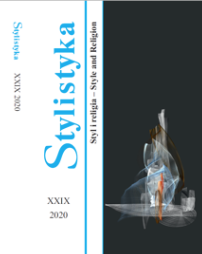Система жанров религиозного стиля
The genre system of the religious style
Author(s): Tatʹâna V. IckovičSubject(s): Theoretical Linguistics, Applied Linguistics
Published by: Uniwersytet Opolski
Keywords: religious functional style; constructive principle of prototextuality; protogenres; genres; prayer; sermon; hagiography; subgenres; core; periphery
Summary/Abstract: The constructive principle of prototextuality implies an obligatory indestructible connection of all modern genotypes with text prototype: it ensures the continuity and preservation of the canonical worldview constructs contained in a concentrated form in the prototext. The genre samples that the aggregate prototext contains are called proto-genres. There are three of them: prayer, preaching and hagiography. In the modern genre system each proto-genre is the substantive and structural basis of a group of genres derived from it, i.e. modern genre types. Each genre type on a generic basis is divided into genres and subgenres. The genre type of modern functional religious style can be represented as a conceptual field. The core of each genre subsystem is made up of genres used in the liturgical sphere; they are as close as possible to the proto-genre in a formal-substantive sense. The periphery of the genre subsystem is made up of genres that function in the non-public sphere; they are distinguished by a certain author’s freedom and at the same time retain their connection with the canonical prototext. The genre subsystems, genetically going back to the proto-genres of prayer, sermon and hagiography, have a common communicative framework (subjects of religious communication belong to different worlds; communication is characterized by reverent tonality in relation to God and other representatives of the sacred world), however, they differ in the direction of communication and the way of textual processing content. Thus, all the three subsystems of the religious style went through the development process, each on its own prototext basis. Prayer, preaching and hagiography continue their active existence in the form of genre groups of the modern religious style. The named genre types maintain a central location in the genre system of religious functional style. Along with it, the periphery of the style is being actively created, formed by genres that do not perform the liturgical functions themselves and are at the intersection with other functional styles. The periphery is constituted by texts with a degree of freedom acceptable for religious Orthodox consciousness that relate to various types of religious activity and ensure the existence of the Church as a social institution of a society. Nevertheless, reliance on prototext is also a characteristic feature of peripheral texts. Peripheral genres arise at the intersection of a religious functional style with other styles. Hybrid genres are especially active in the mass media and on the Internet, where the religious functional style interacts with journalistic and conversational styles. Currently, the sphere of religious confessional journalism and religious Internet communication has taken shape.
Journal: Stylistyka
- Issue Year: 2020
- Issue No: XXIX
- Page Range: 55-77
- Page Count: 23
- Language: Russian

